Application electric current of high-frequency in physiotherapy
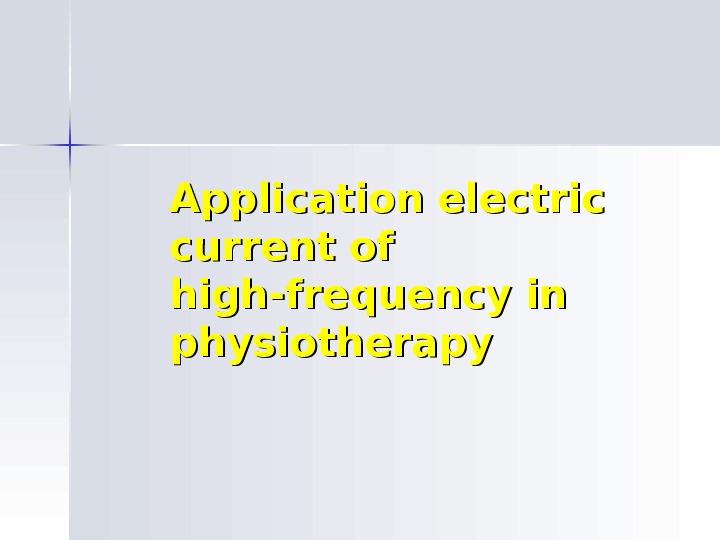
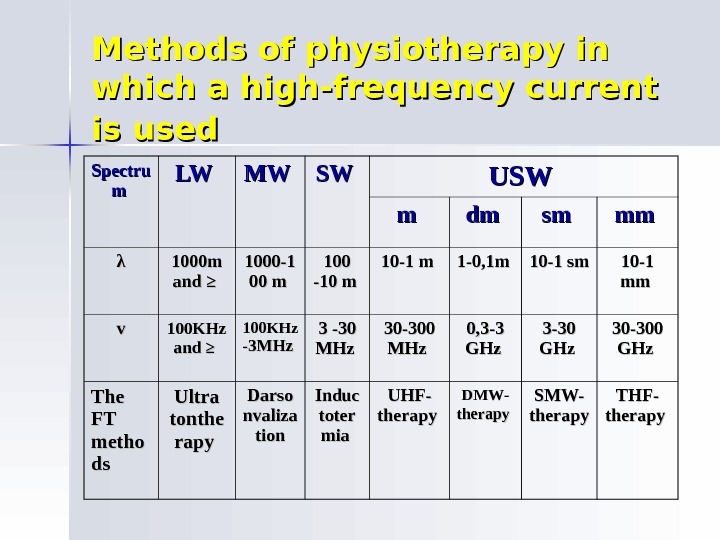
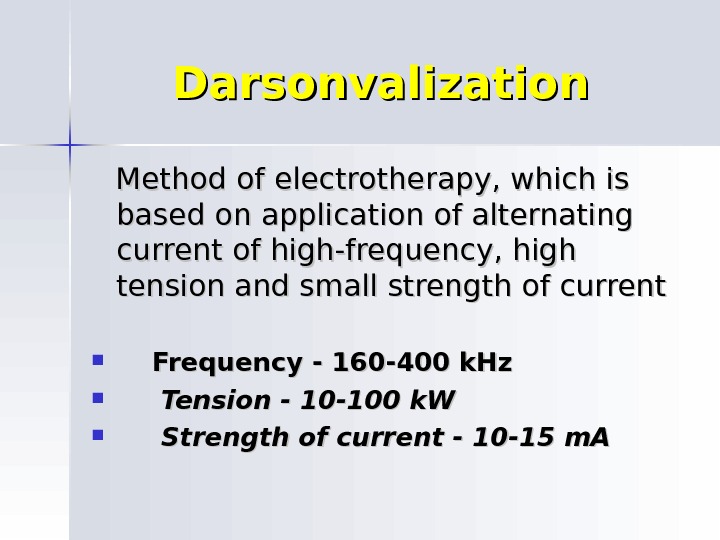



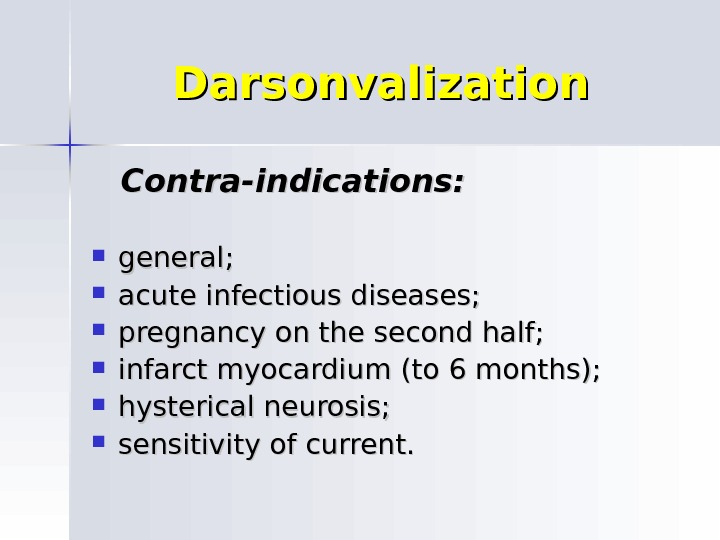
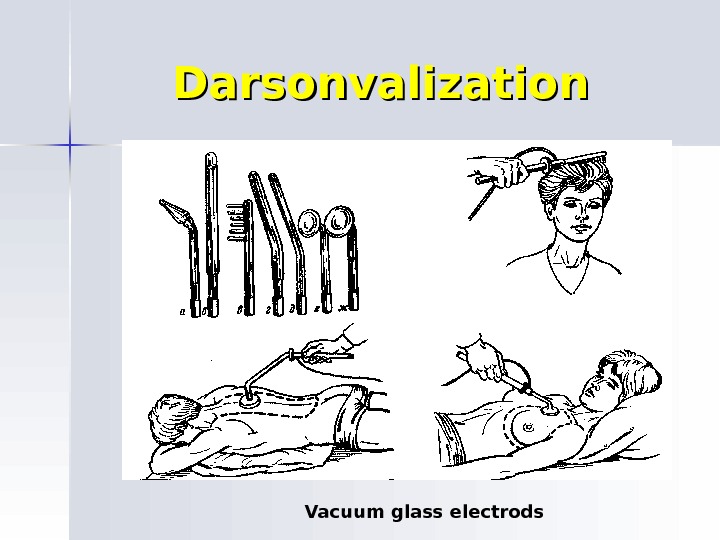

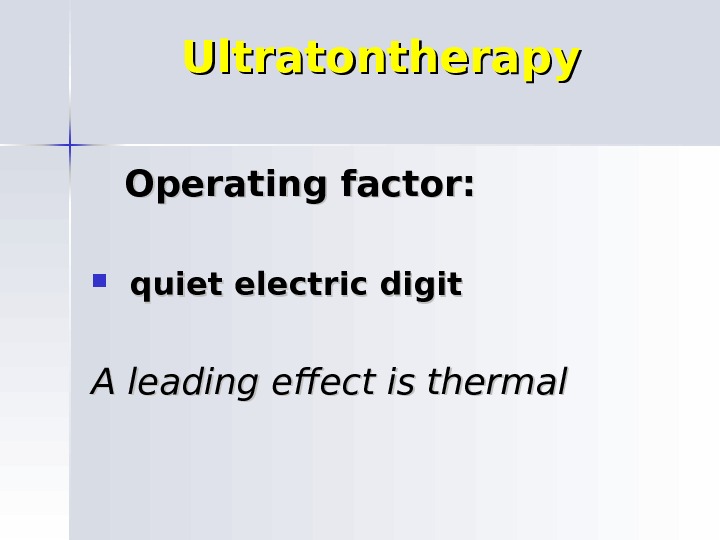
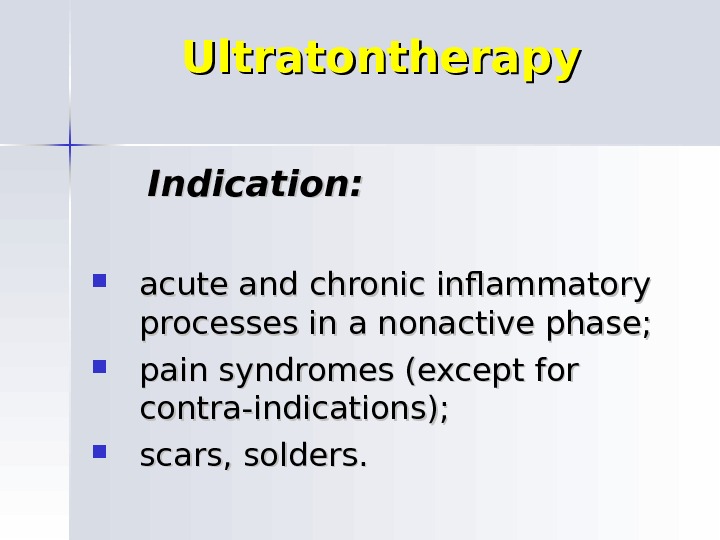
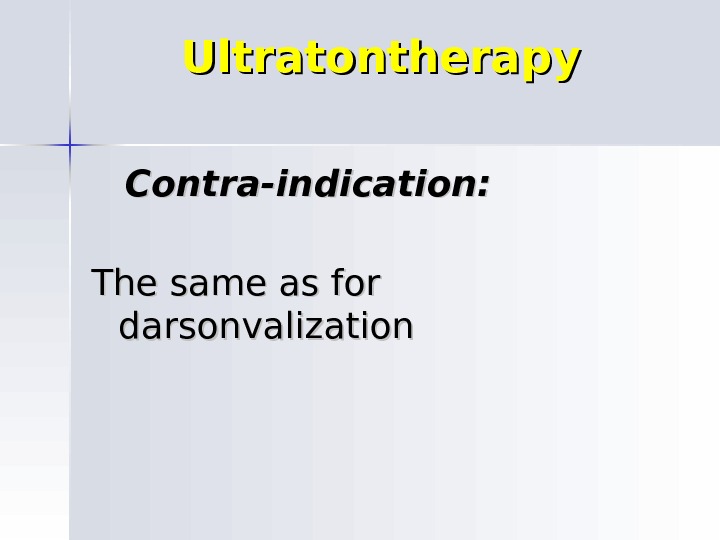
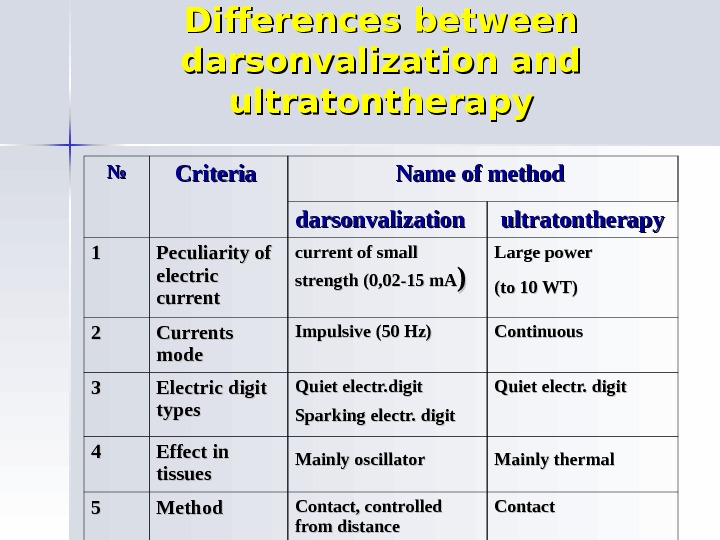


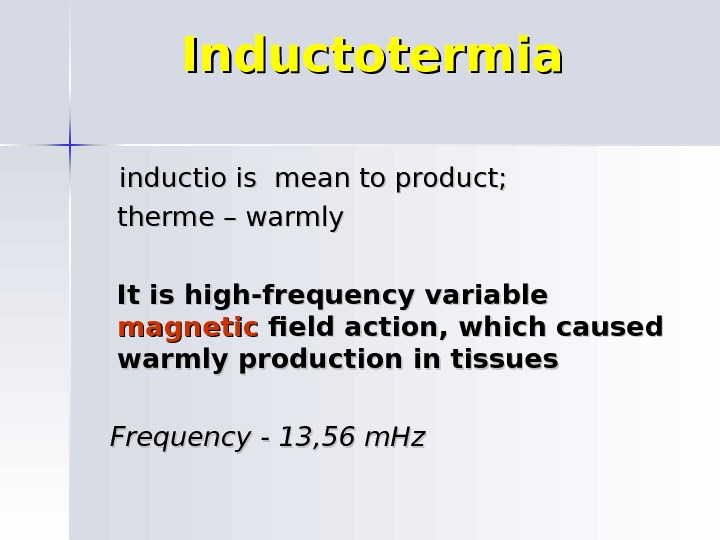
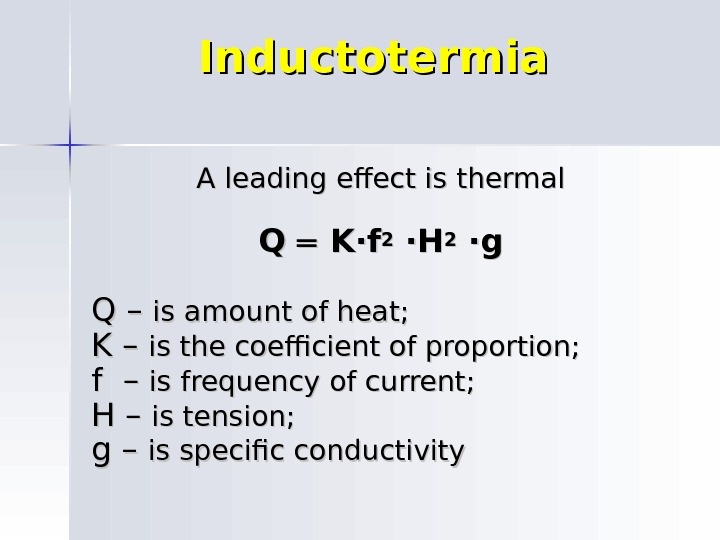
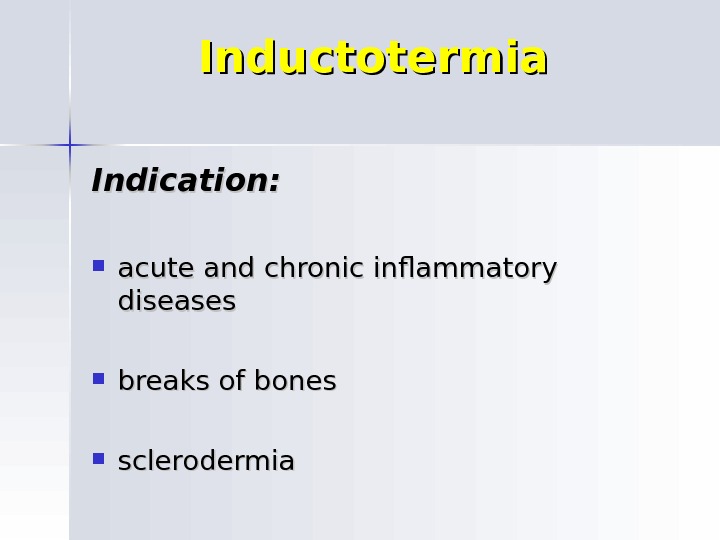


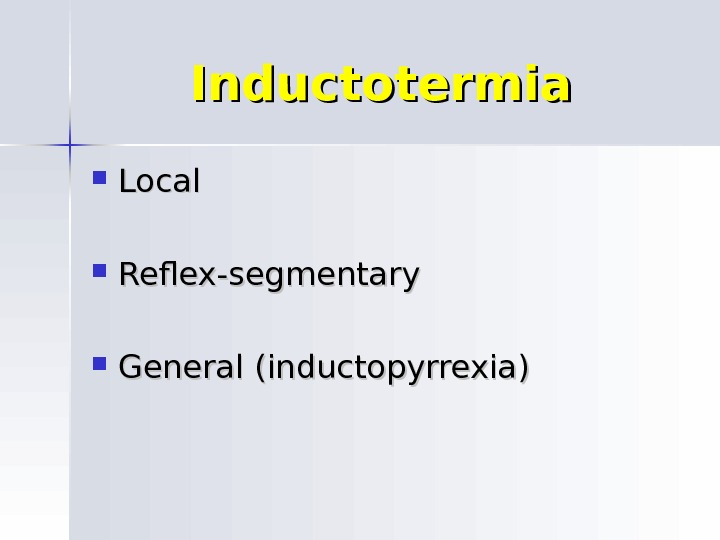
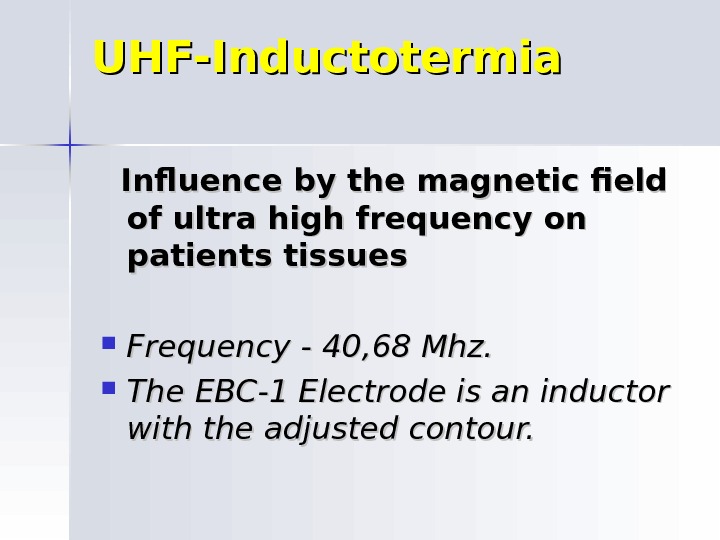





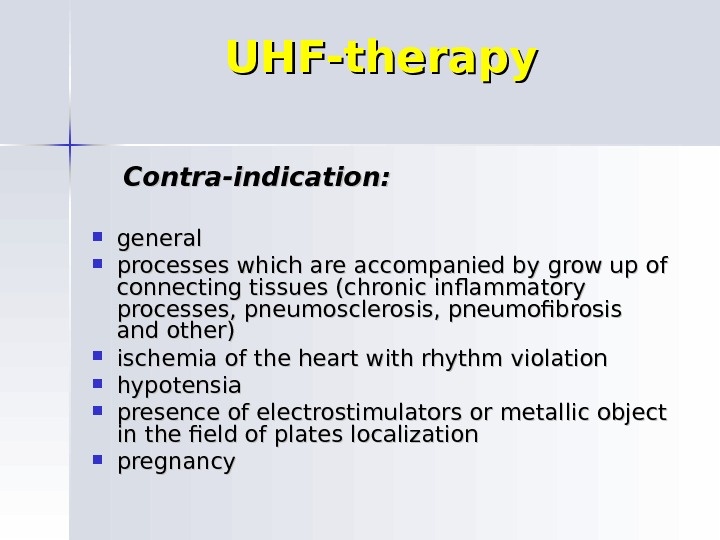
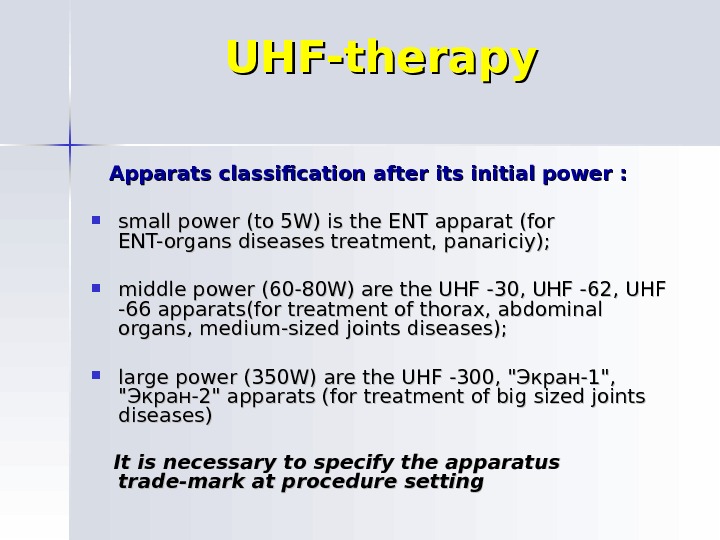

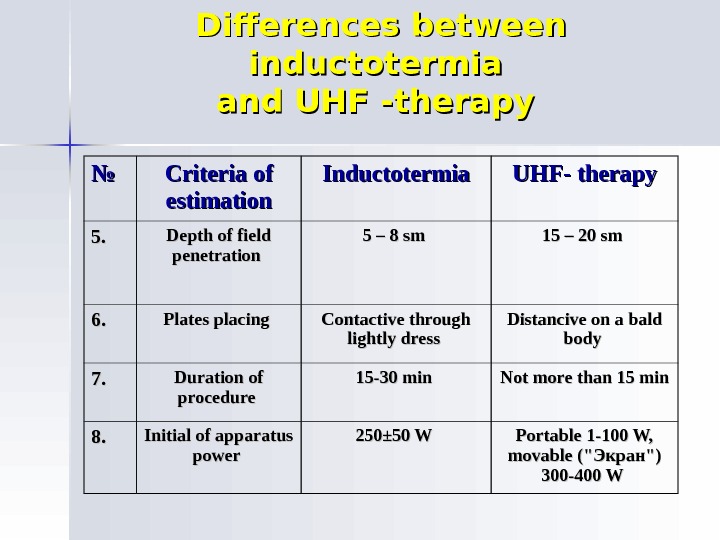
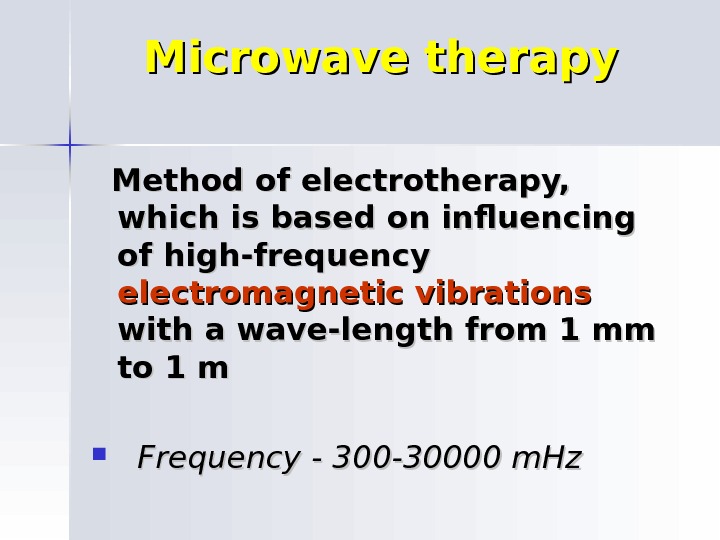

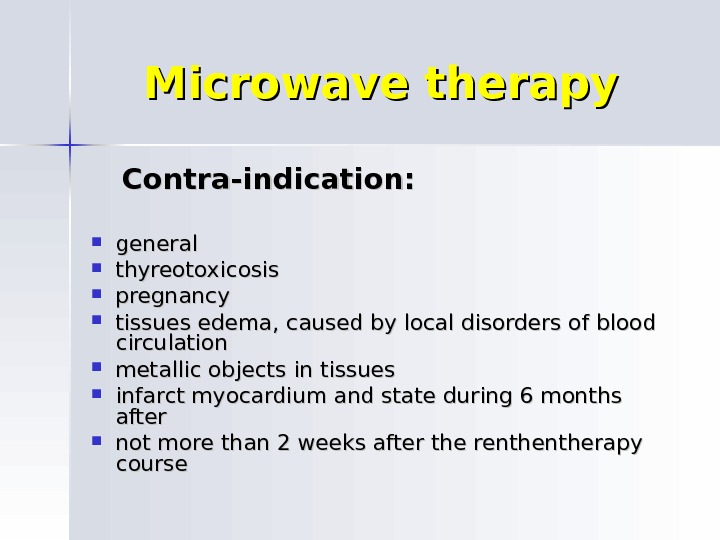


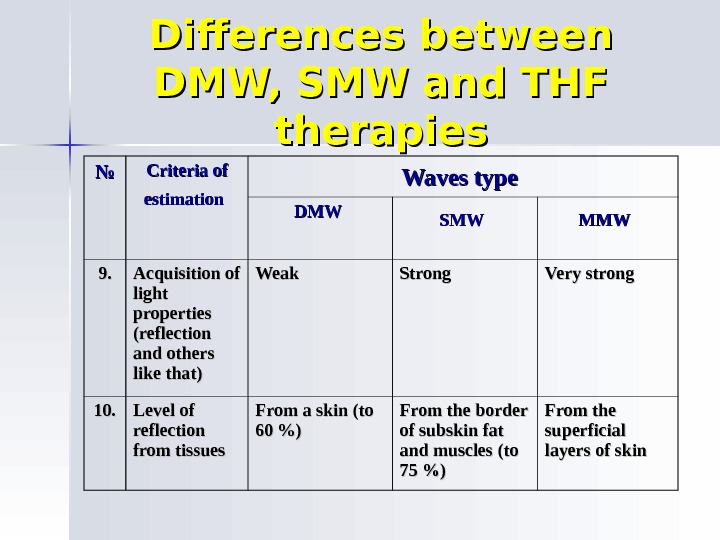



high_frequency_current-1_-1012.ppt
- Размер: 961.5 Кб
- Количество слайдов: 40
Описание презентации Application electric current of high-frequency in physiotherapy по слайдам
 Application electric current of high-frequency in physiotherapy
Application electric current of high-frequency in physiotherapy
 Methods of physiotherapy in which a high-frequency current is used Spectru mm LWLW MWMW SWSW USWUSW mm dmdm smsm mmmm λλ 1000 m and ≥ 1000 -1 00 m 100 -10 m 10 -1 m 1 -0, 1 m 10 -1 sm 10 -1 mmmm vv 100 KHz and ≥ 100 KHz — 3 MHz 3 -30 MHz 30 -300 MHz 0, 3 -3 GHz 3 -30 GHz 30 -300 GHz The FT FT metho dsds Ultra tonthe rapy Darso nvaliza tion Induc toter miamia UHF- therapy DMWDMW — — therapy SMW- therapy THF- therapy
Methods of physiotherapy in which a high-frequency current is used Spectru mm LWLW MWMW SWSW USWUSW mm dmdm smsm mmmm λλ 1000 m and ≥ 1000 -1 00 m 100 -10 m 10 -1 m 1 -0, 1 m 10 -1 sm 10 -1 mmmm vv 100 KHz and ≥ 100 KHz — 3 MHz 3 -30 MHz 30 -300 MHz 0, 3 -3 GHz 3 -30 GHz 30 -300 GHz The FT FT metho dsds Ultra tonthe rapy Darso nvaliza tion Induc toter miamia UHF- therapy DMWDMW — — therapy SMW- therapy THF- therapy
 Darsonvalization Method of electrotherapy, which is based on application of alternating current of high-frequency, high tension and small strength of current Frequency — 160 -400 k. Hz Tension — 10 -100 k. W Strength of current — 10 -15 m.
Darsonvalization Method of electrotherapy, which is based on application of alternating current of high-frequency, high tension and small strength of current Frequency — 160 -400 k. Hz Tension — 10 -100 k. W Strength of current — 10 -15 m.
 Darsonvalization Operating factors: quiet electric digit (discharge) sparking electric digit A leading effect is an oscillator
Darsonvalization Operating factors: quiet electric digit (discharge) sparking electric digit A leading effect is an oscillator
 Darsonvalization Therapeutic effects: vessels tone is normalized vein stagnation diminishes tissues trofic gets better bactericidal and bacteriostatical actions increases anaesthetic effects is activated
Darsonvalization Therapeutic effects: vessels tone is normalized vein stagnation diminishes tissues trofic gets better bactericidal and bacteriostatical actions increases anaesthetic effects is activated
 Darsonvalization Indications : : skins trofic violation, hairs fall; parodontosis, gingivitis, glosalgia; vasomotorial rinitis, the Reino illness, initial stage of obliterial endarteriitis; varicose veins, haemorrhoidal veins dilated; paraestesia, migraine; wounds which heal over slowly.
Darsonvalization Indications : : skins trofic violation, hairs fall; parodontosis, gingivitis, glosalgia; vasomotorial rinitis, the Reino illness, initial stage of obliterial endarteriitis; varicose veins, haemorrhoidal veins dilated; paraestesia, migraine; wounds which heal over slowly.
 Darsonvalization Contra-indications: general; acute infectious diseases; pregnancy on the second half; infarct myocardium (to 6 months); hysterical neurosis; sensitivity of current.
Darsonvalization Contra-indications: general; acute infectious diseases; pregnancy on the second half; infarct myocardium (to 6 months); hysterical neurosis; sensitivity of current.
 Darsonvalization Vacuum glass electrods
Darsonvalization Vacuum glass electrods
 Ultratontherapy Application alternating sinusoidic current of high-frequency, high tension with initial power to 10 WT with the medical purpose Frequency — by 22 k. Hz Tension — 4 -5 k. W
Ultratontherapy Application alternating sinusoidic current of high-frequency, high tension with initial power to 10 WT with the medical purpose Frequency — by 22 k. Hz Tension — 4 -5 k. W
 Ultratontherapy Operating factor: quiet electric digit A leading effect is thermal
Ultratontherapy Operating factor: quiet electric digit A leading effect is thermal
 Ultratontherapy Indication: acute and chronic inflammatory processes in a nonactive phase; pain syndromes (except for contra-indications); scars, solders.
Ultratontherapy Indication: acute and chronic inflammatory processes in a nonactive phase; pain syndromes (except for contra-indications); scars, solders.
 Ultratontherapy Contra-indication: The same as for darsonvalization
Ultratontherapy Contra-indication: The same as for darsonvalization
 Differences between darsonvalization and ultratontherapy №№ Criteria Name of method darsonvalization ultratontherapy 11 Peculiarity of electric current of small strength (0, 02 -15 m. A )) Large power (to 10 WT) 22 Currents mode Impulsive (50 Hz) Continuous 33 Electric digit types Quiet electr. digit Sparking electr. digit Quiet electr. digit 44 Effect in tissues Mainly oscillator Mainly thermal 55 Method Contact, controlled from distance Contact
Differences between darsonvalization and ultratontherapy №№ Criteria Name of method darsonvalization ultratontherapy 11 Peculiarity of electric current of small strength (0, 02 -15 m. A )) Large power (to 10 WT) 22 Currents mode Impulsive (50 Hz) Continuous 33 Electric digit types Quiet electr. digit Sparking electr. digit Quiet electr. digit 44 Effect in tissues Mainly oscillator Mainly thermal 55 Method Contact, controlled from distance Contact
 Differences between darsonvalization and ultratontherapy №№ Criteria Name of method darsonvalization ultratontherapy 66 Peculiarity of of action on a skin Causes the sickly skin irritation (large frequency and tension) Does not cause the sickly skin irritations (less frequency and tension) 77 Peculiarity of of hyperemia Weak (through the weak current thermal effect) Strong (through the considerable current thermal effect) 88 Thermal effect in tissues Weak Considerable 99 EE lectrodes aa mount
Differences between darsonvalization and ultratontherapy №№ Criteria Name of method darsonvalization ultratontherapy 66 Peculiarity of of action on a skin Causes the sickly skin irritation (large frequency and tension) Does not cause the sickly skin irritations (less frequency and tension) 77 Peculiarity of of hyperemia Weak (through the weak current thermal effect) Strong (through the considerable current thermal effect) 88 Thermal effect in tissues Weak Considerable 99 EE lectrodes aa mount
 Differences between darsonvalization and ultratontherapy №№ Criteria Name of method darsonvalization ultratontherapy 11 00 Patients Children after 7 years (it is painfulness method) Children from the first years of life (absence of painfulness) 1111 Indication to application Illnesses in basis of which lie vascular diseases (the Reino illness, cardialgia, head pain), and also wounds, trophic ulcers Acute and chronic inflammatory processes, scars, pain syndromes
Differences between darsonvalization and ultratontherapy №№ Criteria Name of method darsonvalization ultratontherapy 11 00 Patients Children after 7 years (it is painfulness method) Children from the first years of life (absence of painfulness) 1111 Indication to application Illnesses in basis of which lie vascular diseases (the Reino illness, cardialgia, head pain), and also wounds, trophic ulcers Acute and chronic inflammatory processes, scars, pain syndromes
 Inductotermia inductio is mean to product; therme – warmly It is high-frequency variable magnetic field action, which caused warmly production in tissues Frequency — 13, 56 m. Hz
Inductotermia inductio is mean to product; therme – warmly It is high-frequency variable magnetic field action, which caused warmly production in tissues Frequency — 13, 56 m. Hz
 Inductotermia A leading effect is thermal QQ ═ ═ KK ∙∙ ff 22 ∙∙ HH 22 ∙∙ gg QQ – – is amount of heat; KK – – is the coefficient of proportion; ff –– is frequency of current; HH – – is tension; gg – – is specific conductivity
Inductotermia A leading effect is thermal QQ ═ ═ KK ∙∙ ff 22 ∙∙ HH 22 ∙∙ gg QQ – – is amount of heat; KK – – is the coefficient of proportion; ff –– is frequency of current; HH – – is tension; gg – – is specific conductivity
 Inductotermia Indication: acute and chronic inflammatory diseases breaks of bones sclerodermia
Inductotermia Indication: acute and chronic inflammatory diseases breaks of bones sclerodermia
 Inductotermia Contra-indication: general purulent processes during 6 months after infarct myocardium thyreotocsicosis presence of electrostimulators or metallic object in the field of inductor localization
Inductotermia Contra-indication: general purulent processes during 6 months after infarct myocardium thyreotocsicosis presence of electrostimulators or metallic object in the field of inductor localization
 Inductotermia Inductor-disc, Inductor-cabel
Inductotermia Inductor-disc, Inductor-cabel
 Inductotermia Local Reflex-segmentary General ( ( inductopyrrexia ))
Inductotermia Local Reflex-segmentary General ( ( inductopyrrexia ))
 UHF-Inductotermia Influence by the magnetic field of ultra high frequency on patients tissues Frequency — 40, 68 Mhz. The ЕВС-1 Electrode is an inductor with the adjusted contour.
UHF-Inductotermia Influence by the magnetic field of ultra high frequency on patients tissues Frequency — 40, 68 Mhz. The ЕВС-1 Electrode is an inductor with the adjusted contour.
 UHF-Inductotermia Indication: Acute and sub-acute inflammatory diseases, especially, in the face area (antritis, otitis, neuritis of facial nerve)
UHF-Inductotermia Indication: Acute and sub-acute inflammatory diseases, especially, in the face area (antritis, otitis, neuritis of facial nerve)
 UHF-Inductotermia Contra-indication: The same as for inductotermia
UHF-Inductotermia Contra-indication: The same as for inductotermia
 UHF-therapy Influence by the variable electric field (in a less measure magnetic) of ultrahigh frequency on the patients organism A leading effect is an oscillator Frequency — 40, 68 Mhz
UHF-therapy Influence by the variable electric field (in a less measure magnetic) of ultrahigh frequency on the patients organism A leading effect is an oscillator Frequency — 40, 68 Mhz
 UHF-therapy Basic effects: activates formation of connecting tissue; activates fagocitosis; diminishes the tissues edema; extends vessels; activates the metabolism; diminishes pain; multiplies the Са++++ level in a blood; takes off the musculature spasm.
UHF-therapy Basic effects: activates formation of connecting tissue; activates fagocitosis; diminishes the tissues edema; extends vessels; activates the metabolism; diminishes pain; multiplies the Са++++ level in a blood; takes off the musculature spasm.
 UHF-therapy Indication: Acute and chronic inflammatory diseases of internal organs which are accompanied by the edema
UHF-therapy Indication: Acute and chronic inflammatory diseases of internal organs which are accompanied by the edema
 UHF-therapy Contra-indication: general processes which are accompanied by grow up of connecting tissues (chronic inflammatory processes, pneumosclerosis, pneumofibrosis and other) ischemia of the heart with rhythm violation hypotensia presence of electrostimulators or metallic object in the field of plates localization pregnancy
UHF-therapy Contra-indication: general processes which are accompanied by grow up of connecting tissues (chronic inflammatory processes, pneumosclerosis, pneumofibrosis and other) ischemia of the heart with rhythm violation hypotensia presence of electrostimulators or metallic object in the field of plates localization pregnancy
 UHF-therapy Apparats classification after its initial power : small power (to 5 W) is the ENT apparat (for ENT-organs diseases treatment, panariciy); middle power (60 -80 W) are the UHF -30 , UHF -62 , UHF -66 -66 apparats(for treatment of thorax, abdominal organs, medium-sized joints diseases); large power (350 W) are the UHF -300 , «Экран-1», «Экран-2» apparats (for treatment of big sized joints diseases) It is necessary to specify the apparatus trade-mark at procedure setting
UHF-therapy Apparats classification after its initial power : small power (to 5 W) is the ENT apparat (for ENT-organs diseases treatment, panariciy); middle power (60 -80 W) are the UHF -30 , UHF -62 , UHF -66 -66 apparats(for treatment of thorax, abdominal organs, medium-sized joints diseases); large power (350 W) are the UHF -300 , «Экран-1», «Экран-2» apparats (for treatment of big sized joints diseases) It is necessary to specify the apparatus trade-mark at procedure setting
 Differences between inductotermia and UHF -therapy №№ Criteria of estimation Inductotermia UHFUHF — therapy 1. 1. Operating factor Variable magnetic field HF(13, 56 m. Hz) Variable electric field UHF (40, 68 m. Hz) 2. 2. Effect in tissues Mainly thermal Mainly oscillator 3. 3. Category of illnesses Chronic inflammatory processes Acute inflammatory processes with the edema 4. 4. Amount of plates 1 inductor disk or inductor cable 2 condensators plates
Differences between inductotermia and UHF -therapy №№ Criteria of estimation Inductotermia UHFUHF — therapy 1. 1. Operating factor Variable magnetic field HF(13, 56 m. Hz) Variable electric field UHF (40, 68 m. Hz) 2. 2. Effect in tissues Mainly thermal Mainly oscillator 3. 3. Category of illnesses Chronic inflammatory processes Acute inflammatory processes with the edema 4. 4. Amount of plates 1 inductor disk or inductor cable 2 condensators plates
 Differences between inductotermia and UHF -therapy №№ Criteria of estimation Inductotermia UHFUHF — therapy 55. . Depth of field penetration 5 – 8 sm 15 – 20 sm 66. . Plates placing Contactive through lightly dress Distancive on a bald body 77. . Duration of procedure 15 -30 min Not more than 15 min 88. . Initial of apparatus power 250± 50 W Portable 1 -100 W, movable («Экран») 300 -400 W
Differences between inductotermia and UHF -therapy №№ Criteria of estimation Inductotermia UHFUHF — therapy 55. . Depth of field penetration 5 – 8 sm 15 – 20 sm 66. . Plates placing Contactive through lightly dress Distancive on a bald body 77. . Duration of procedure 15 -30 min Not more than 15 min 88. . Initial of apparatus power 250± 50 W Portable 1 -100 W, movable («Экран») 300 -400 W
 Microwave therapy Method of electrotherapy, which is based on influencing of high-frequency electromagnetic vibrations with a wave-length from 1 mm to 1 m Frequency — 300 -30000 m. Hz
Microwave therapy Method of electrotherapy, which is based on influencing of high-frequency electromagnetic vibrations with a wave-length from 1 mm to 1 m Frequency — 300 -30000 m. Hz
 Microwave therapy Indication: joints degenerative-distrophy diseases of extremities and spine chronic and subacute inflammatory processes stomach ulcerous illness without propensity to bleeding obliterial diseases of extremities vessels infiltrate after operation
Microwave therapy Indication: joints degenerative-distrophy diseases of extremities and spine chronic and subacute inflammatory processes stomach ulcerous illness without propensity to bleeding obliterial diseases of extremities vessels infiltrate after operation
 Microwave therapy Contra-indication: general thyreotoxicosis pregnancy tissues edema, caused by local disorders of blood circulation metallic objects in tissues infarct myocardium and state during 6 months after not more than 2 weeks after the renthentherapy course
Microwave therapy Contra-indication: general thyreotoxicosis pregnancy tissues edema, caused by local disorders of blood circulation metallic objects in tissues infarct myocardium and state during 6 months after not more than 2 weeks after the renthentherapy course
 Differences between DMW, SMW and THF therapies №№ Criteria of estimation Waves type DMWDMW SMWSMW MMWMMW 1. 1. Name of method DMW -therapy SMW -therapy THF-therapy 2. 2. Frequency of el. -mag. vibrations 300 -3000 m. Hz 3 -30 g. Hz 30 -300 g. Hz 3. 3. Length of waves 1 -10 dmdm 1 -10 sm sm 1 -10 mm mm 4. 4. Absorption by tissues Weak Strong Very strong 5. 5. Waves fading in tissues Weak Strong (in 2 times quickly, than DMW) Very strong (in 3 quickly, than DMW and SMW) 6. 6. Depth of penetration in tissues 10 -12 sm sm 5 -65 -6 sm sm 0, 2 -0, 6 mm mm
Differences between DMW, SMW and THF therapies №№ Criteria of estimation Waves type DMWDMW SMWSMW MMWMMW 1. 1. Name of method DMW -therapy SMW -therapy THF-therapy 2. 2. Frequency of el. -mag. vibrations 300 -3000 m. Hz 3 -30 g. Hz 30 -300 g. Hz 3. 3. Length of waves 1 -10 dmdm 1 -10 sm sm 1 -10 mm mm 4. 4. Absorption by tissues Weak Strong Very strong 5. 5. Waves fading in tissues Weak Strong (in 2 times quickly, than DMW) Very strong (in 3 quickly, than DMW and SMW) 6. 6. Depth of penetration in tissues 10 -12 sm sm 5 -65 -6 sm sm 0, 2 -0, 6 mm mm
 Differences between DMW, SMW and THF therapies №№ Criteria of estimation Waves type DMWDMW SMWSMW MMWMMW 7. 7. Level of waves penetration in tissues Deep tissues Skin, subskin and adjoining tissues Epidermis and reticular layers of skin 8. 8. Approaching of el-mag. frequency vibrations to frequency of light waves Weak Strong Very strong
Differences between DMW, SMW and THF therapies №№ Criteria of estimation Waves type DMWDMW SMWSMW MMWMMW 7. 7. Level of waves penetration in tissues Deep tissues Skin, subskin and adjoining tissues Epidermis and reticular layers of skin 8. 8. Approaching of el-mag. frequency vibrations to frequency of light waves Weak Strong Very strong
 Differences between DMW, SMW and THF therapies №№ Criteria of estimation Waves type DMWDMW SMWSMW MMWMMW 9. 9. Acquisition of light properties (reflection and others like that) Weak Strong Very strong 10. Level of reflection from tissues From a skin (to 60 %) From the border of subskin fat and muscles (to 75 %) From the superficial layers of skin
Differences between DMW, SMW and THF therapies №№ Criteria of estimation Waves type DMWDMW SMWSMW MMWMMW 9. 9. Acquisition of light properties (reflection and others like that) Weak Strong Very strong 10. Level of reflection from tissues From a skin (to 60 %) From the border of subskin fat and muscles (to 75 %) From the superficial layers of skin
 Differences between DMW, SMW and THF therapies №№ Criteria of estimation Waves type DMWDMW SMWSMW MMWMMW 1111 Formation of standing waves Not characteristically Characteristically Not characteristically 1212 Place of heat formation Evenly in upper and deep tissues Upper layers of tissues Skin and adjoining tissues
Differences between DMW, SMW and THF therapies №№ Criteria of estimation Waves type DMWDMW SMWSMW MMWMMW 1111 Formation of standing waves Not characteristically Characteristically Not characteristically 1212 Place of heat formation Evenly in upper and deep tissues Upper layers of tissues Skin and adjoining tissues
 Differences between DMW, SMW and THF therapies №№ Criteria of estimation Waves type DMWDMW SMWSMW MMWMMW 1313 Change of tissues temperature +4˚ — +6˚ С +2˚ — +5˚ С +0, 1˚ С 1414 Irritation of receptors The skin receptors do not get irritated, only interoreceptors of muscles, vessels and internal organs Skin termoreceptors, contact and pain receptors The skin receptors
Differences between DMW, SMW and THF therapies №№ Criteria of estimation Waves type DMWDMW SMWSMW MMWMMW 1313 Change of tissues temperature +4˚ — +6˚ С +2˚ — +5˚ С +0, 1˚ С 1414 Irritation of receptors The skin receptors do not get irritated, only interoreceptors of muscles, vessels and internal organs Skin termoreceptors, contact and pain receptors The skin receptors
 Differences between DMW, SMW and THF therapies №№ Criteria of estimation Waves type DMWDMW SMWSMW MMWMMW 15. Accordance of frequency of el-mag. vibrations with the biorhythms of biological substanses Strong with amino acid, proteins, linked water More weak with amino acid, proteins, linked water Strong with molecules, atoms, DNA 16. Biophysical and biochemical changes in tissues Strong Not strong Considerable
Differences between DMW, SMW and THF therapies №№ Criteria of estimation Waves type DMWDMW SMWSMW MMWMMW 15. Accordance of frequency of el-mag. vibrations with the biorhythms of biological substanses Strong with amino acid, proteins, linked water More weak with amino acid, proteins, linked water Strong with molecules, atoms, DNA 16. Biophysical and biochemical changes in tissues Strong Not strong Considerable
